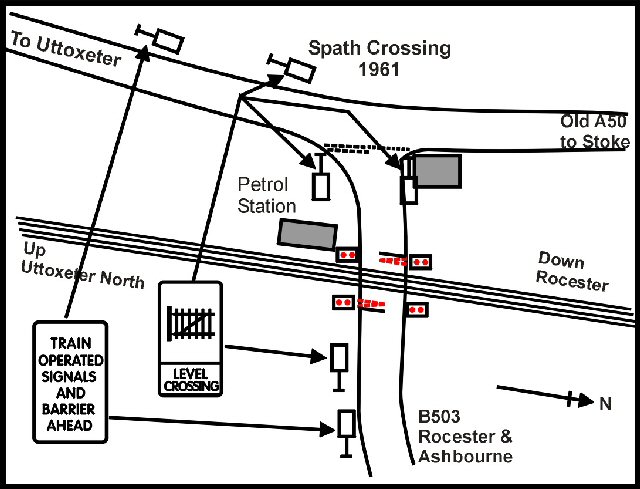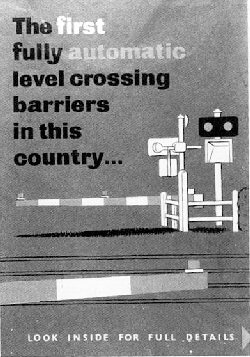
Spath after modernisation

Sam Hallas' Website
Britain's First Automatic Level Crossing
What was proposed for Spath was what we today refer to as Automatic Half Barriers. The barriers and control equipment at Spath were manufactured by the Westinghouse Brake and Signal Company Ltd to a design produced by the British Transport Commission and based upon the Provisional Requirements of 1958.
As they are so prevalent today, it is somewhat unnecessary to describe what an Automatic Half Barrier level crossing looks like or what equipment was installed. Most will be aware that the single steady amber indication to road traffic was not present in the original installations, otherwise, apart from a curiously old-fashioned look, the crossing at Spath was equipped in a manner very similar to today's crossings.
The pioneer crossing was equipped with a "Another Train Coming" notice which was not universally fitted to subsequent crossings. Whereas the modern standard is to place this illuminating sign under the primary Stop road signals, the original had them on the far side of the crossing under secondary "Stop" signals – which were themselves dispensed with in later installations.
Lowering of the barriers was caused by occupation of Track Circuit "T.4" (up line) or "T.2" (down line) after delay of eight seconds. Raising of barriers was invoked by occupation and clearance of Track Circuit "T.4" and Treadle "Q4" being operated (up line) or "T.3" and Treadle "Q3" (down line) unless a second train intervened. The barriers were maintained down and "Second Train Coming" indicators illuminated by occupation of Track Circuit "T.5" (up line) or "T.1" (down line) when a second train intervened. The position of barriers was indicated in Uttoxeter North signal box as was the state of the power supply.

Spath after modernisation
The position of the Point of Operation and Strike-In Point was, course, dictated by the maximum line speed so as to ensure a minimum of five seconds would elapse between the barriers reaching the lowered position and the fastest train passing. In the original specification produced by the London Midland Region, these distances were worked out based on an assumed line speed of 60mph (it was thought "advisable" to do so). On that basis, the Point of Operation was set at 616yds and the Strike In Point at 909yds.
By 1st July 1960, it had no longer been thought so advisable to cater for 60mph running so the distances were revised to 472yds and 652yds respectively, as required for 45mph. These distances were to be again revised, this time for 55mph, only a few months after the crossing was brought into use. This was because the railway pointed out that steam hauled express freights used the line and they were not necessarily equipped with a speedometer
.Meanwhile, there was a considerable amount of debate going on within the Ministry of Transport, this time with its own road engineers. As this was a completely new phenomenon as far as road traffic was concerned, there was intense discussion concerning the road sign requirements. Of course the proximity to a T-junction exacerbated this and the internal (and external) arguments rumbled on long after the crossing was brought into use.
Work to install the equipment commenced in late November 1960. Authority for the crossing was granted by The British Transport Commission (Churnet Valley Line) (Spath Crossing) Order 1960 which came into force on 19th December 1960.
By Thursday 2nd February 1961 work had progress sufficiently to allow Col. McMullen of the Railway Inspectorate to formally inspect the crossing. A locomotive and saloon was provided for the occasion. All must have proceeded smoothly and to the Inspector’s satisfaction with the operation of the equipment as he granted permission for the crossing to be taken into use the following on the Sunday, "subject to completion of the fencing and the road surface as well as attendance at the crossing until further notice".

Publicity Leaflet
As the education of road users was seen as the key to the safety of the system, British Railways embarked on a huge publicity campaign. Leaflets were printed and circulated to all local residents, schools were visited and much use was made of the media – a pattern followed with most new installations ever since.
A press conference was held at the crossing during the morning of Monday 6th February. A special train formed of a two car DMU was arranged to shuttle back and forth between Uttoxeter and Rocester thereby operating the crossing at a variety of speeds. There was a good turn-out of Gentlemen of the Press and stories appeared in all the national papers as well as the Birmingham Post, the Yorkshire Post and the Liverpool Daily Post.
This snippet from the Daily Mail on 30th January is typical of the press coverage (although it predates the actual opening); "ROBOT CROSSING - Britain's first train controlled level crossing was tested yesterday at Spath, Staffordshire. Instead of gates it has red and white poles which are automatically lowered across the road when a train trips and electric contact on the line"
The Financial Times, as befits its market, concentrated on the economics (and thereby provides the only mention I have found of the cost). The FT told its readers that "the Installation has cost between £5,000 and £6,000 but it is estimated that after three years there will be a net saving of about £2,000 a year represented in the wages of the three signalmen who formerly looked after the gates and in maintenance".
Text © Dave Harris. Photos: as attributed. Diagram: Redrawn SMH 2004